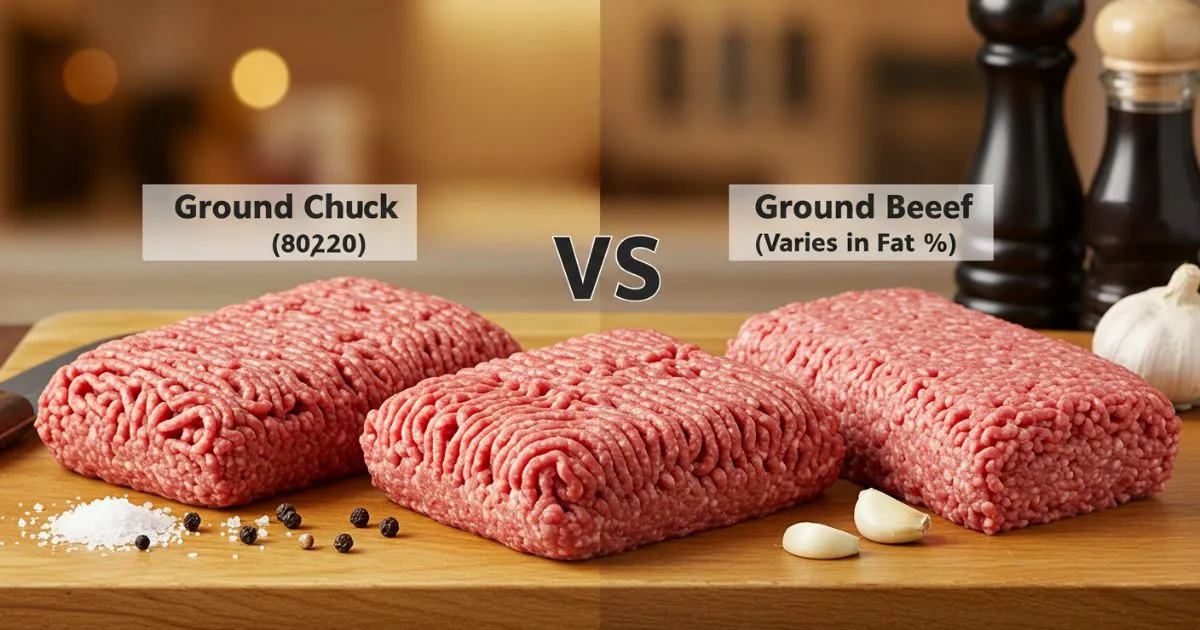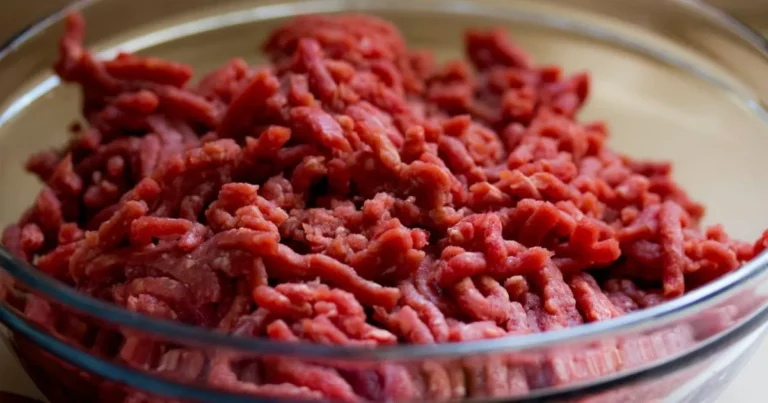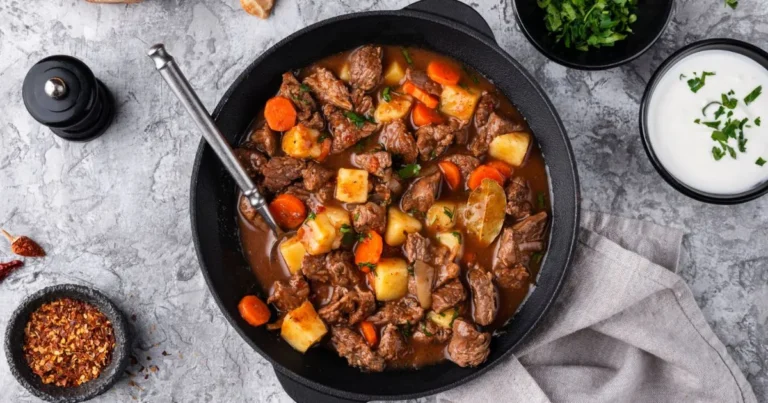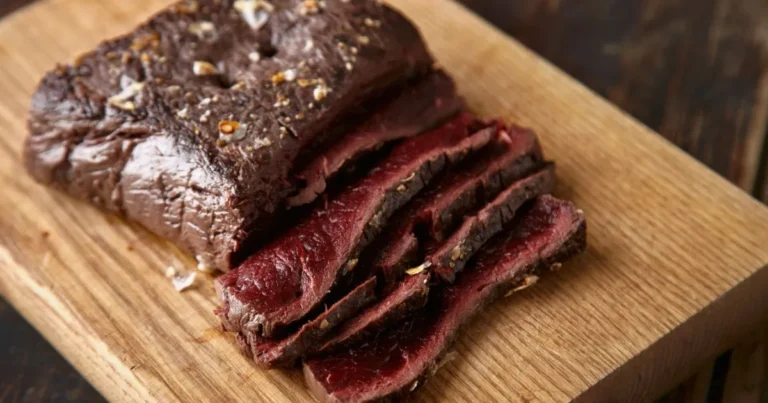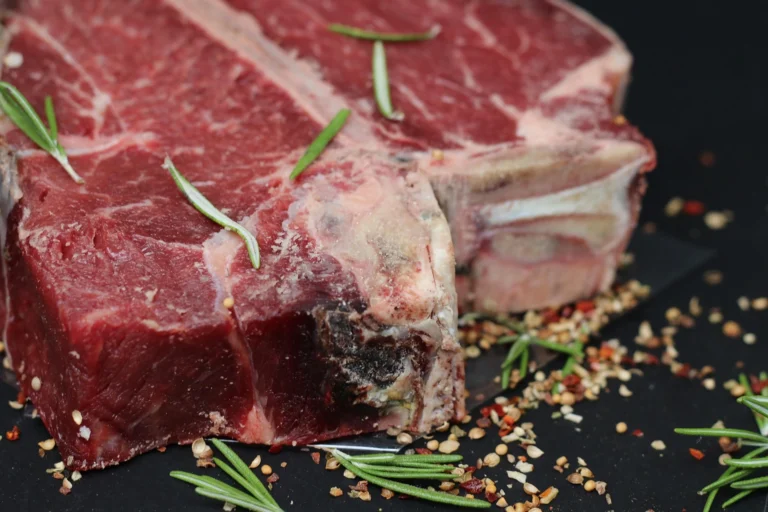Ground Chuck vs Ground Beef: 7 Cooking Tips to Get the Best Flavor
Introduction
When you step into the meat aisle at your local grocery store or visit a butcher shop, you’re often met with a variety of ground meat options. Among them, two popular choices stand out—ground chuck and ground beef.
At first glance, they might seem interchangeable, but if you’re serious about cooking, understanding their differences can take your dishes to the next level.
The type of meat you choose directly affects the texture, juiciness, and overall flavor of your meal. Whether you’re making burgers, meatballs, or a hearty meat sauce, selecting the right cut can mean the difference between an average dish and an unforgettable one.
Ground chuck brings a rich, beefy taste with a slightly firmer bite, while ground beef varies in fat content and consistency, making it versatile but unpredictable in certain recipes.
This guide isn’t just about knowing what sets these two apart—it’s about helping you unlock their full potential in your kitchen.
By the end of this post, you’ll have seven essential tips that will ensure every bite is packed with mouthwatering flavor. Whether you’re a home cook looking to refine your technique or a seasoned pro aiming for perfection, these insights will elevate your cooking game.
So, before you fire up the stove or preheat the grill, let’s break down exactly what you need to know to get the most out of ground chuck and ground beef.
Table of Contents
Ground Chuck vs Ground Beef: What’s the Difference?
If you’ve ever stood in the meat section debating between ground chuck and ground beef, you’re not alone. At first glance, both look nearly identical—red, finely ground, and ready for your next meal.
But the real difference goes beyond appearance, and understanding these details will help you make the best choice for your cooking needs.
Fat Content & Texture: Why It Matters
Fat content is one of the biggest factors separating ground chuck from ground beef. Ground chuck typically comes from the shoulder portion of the cow, meaning it has a consistent fat ratio, usually around 80/20 (80% lean meat, 20% fat). This makes it ideal for dishes you want richness and juiciness, like burgers or meatballs.
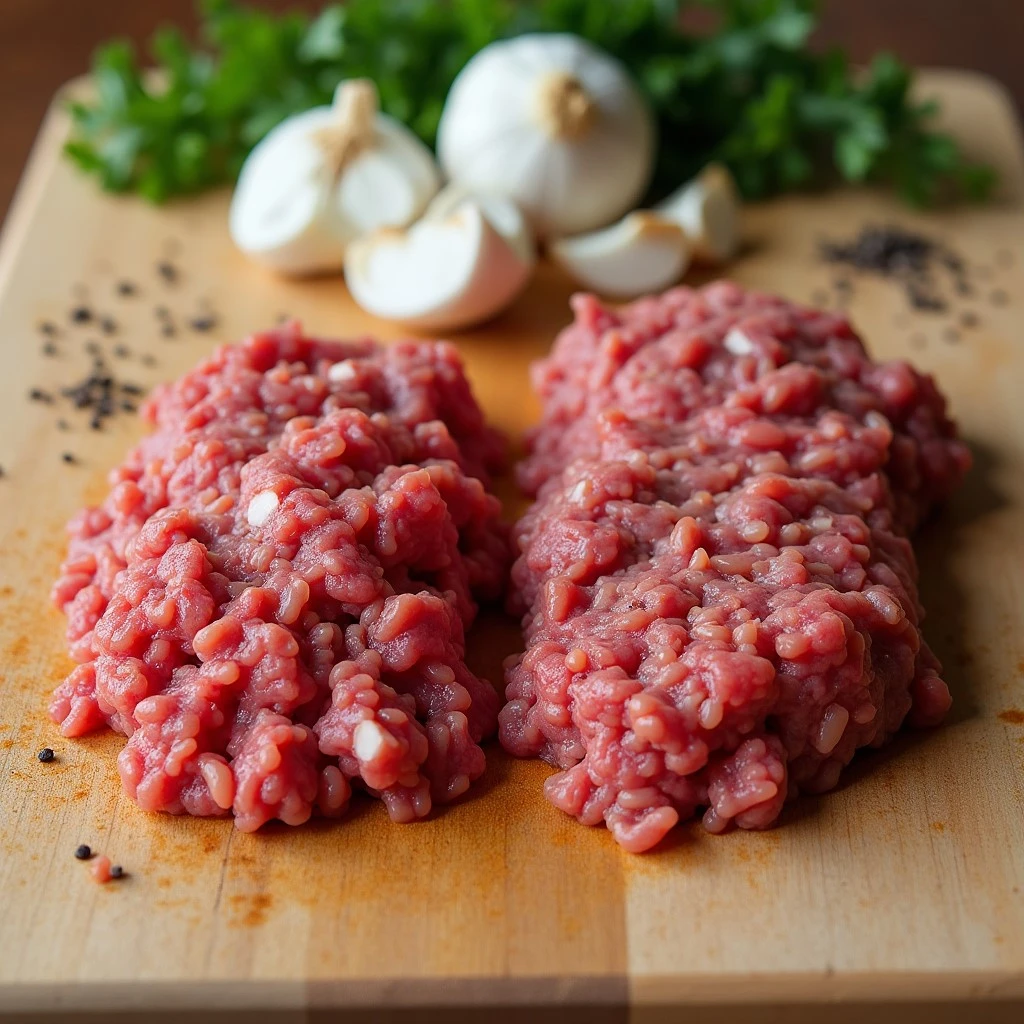
Ground beef, however, is a broader and more versatile category. It can be sourced from various parts of the cow, including trimmings from different cuts.
Because of this, the fat content can vary—you might find lean versions like 90/10 (90% lean, 10% fat) or more balanced options like 85/15.
The downside? Inconsistent texture. One batch might be leaner, while another could have more fat, which affects how it cooks.
If you’re looking for flavor-packed, moist results, ground chuck is the way to go. But if you want a leaner option for tacos, chili, or casseroles, ground beef gives you more flexibility.
Best Uses for Each Type of Meat
Choosing between ground chuck and ground beef isn’t just about fat percentage—it’s about how you plan to use it.
- Ground Chuck – Perfect for burgers, meatballs, and meatloaf. The higher fat content keeps the meat moist and flavorful, especially when cooked over high heat.
- Ground Beef – Great for tacos, spaghetti sauce, and casseroles, where texture and leanness matter more than juiciness. A leaner mix prevents excess grease, making your dish lighter.
If you’re grilling burgers, ground chuck is your best bet—it holds its shape well and won’t dry out. But if you’re making a slow-cooked sauce, leaner ground beef blends well without making the dish greasy.
Where to Buy Quality Meat
Now that you know the difference, the next step is finding high-quality meat. You can grab pre-packaged options from a supermarket, but if you want the freshest selection, head to a butcher shop.
They often grind meat in-house, meaning better texture, less processing, and fresher taste.
When buying from a grocery store, check the USDA label. “USDA Choice” or “USDA Prime” means better quality, while store-brand options might come from multiple sources, leading to inconsistent results.
Also, look at the fat distribution—well-marbled meat will cook more evenly and retain flavor better.
Final Thoughts
Ground chuck and ground beef might seem similar, but once you break it down, the differences are clear.
Your choice depends on what you’re cooking, how much fat you need, and how much control you want over flavor and texture. Pick wisely, and you’ll notice a major improvement in your next meal.
Choosing the Right Meat for the Best Flavor
When it comes to cooking, the quality of your ingredients determines the final taste, and ground meat is no exception.
Picking the right meat isn’t just about grabbing the first package you see on the shelf—it’s about understanding fat ratios, freshness, and how different cuts impact the flavor of your dish.
If you’ve ever wondered why some burgers turn out rich and juicy while others taste dry and bland, the secret lies in choosing the right meat from the start.
USDA Meat Grades & Labels: What They Mean for You
Meat isn’t just sold by type—it’s graded based on quality. When shopping for ground chuck or ground beef, you’ll often see USDA labels like Prime, Choice, and Select. These labels indicate marbling, tenderness, and overall meat quality.
- USDA Prime – The highest grade, offering the most marbling and best flavor. Ideal if you want the juiciest, most flavorful results.
- USDA Choice – Slightly less marbled than Prime but still high quality. A solid middle ground that balances flavor and affordability.
- USDA Select – Leaner with minimal marbling. Works well for dishes that don’t rely on fat for moisture but can be drier if not cooked properly.
For burgers, meatballs, or any dish where fat enhances taste, go for USDA Prime or Choice ground chuck. If you’re making a lean dish like tacos or chili, Select-grade ground beef might be a better fit.
Fresh vs. Frozen Ground Beef: Which One Should You Pick?
You’ve probably noticed that some stores sell pre-packaged ground meat while others offer freshly ground options at the butcher counter. So, which one should you choose?
- Freshly Ground Meat – Typically has a better texture and a cleaner, more robust flavor. If you can, buy from a butcher who grinds meat in-house.
- Pre-Packaged Ground Beef – Convenient, but may contain trimmings from multiple cows, leading to inconsistencies in texture and flavor.
- Frozen Ground Beef – Can be a good backup, but freezing affects moisture retention, making it slightly drier when cooked.
If you want the best flavor and texture, always go for fresh, high-quality ground chuck or ground beef. If you’re buying in bulk, portion it out and freeze it yourself to control quality.
Why Fat Percentage Matters in Cooking
The fat-to-lean ratio of your ground meat can make or break a dish. The amount of fat impacts juiciness, tenderness, and how well the meat holds together during cooking.
- 80/20 (80% lean, 20% fat) – The gold standard for burgers, meatballs, and anything where richness and flavor are key.
- 85/15 (85% lean, 15% fat) – A balance of leanness and moisture. Great for taco meat, meat sauces, and casseroles.
- 90/10 (90% lean, 10% fat) or leaner – Best for dishes where you want minimal grease, like stir-fries or stuffed peppers.
For grilling, pan-frying, or roasting, go for a higher fat percentage to keep the meat from drying out. If you’re making a slow-cooked dish like chili or lasagna, leaner ground beef works better since the sauce adds moisture.
Final Thoughts
Choosing the right meat isn’t just about preference—it’s about understanding how fat, freshness, and quality affect the final result.
Next time you’re at the store, take a moment to check the label, ask the butcher about freshly ground options, and pick a fat ratio that suits your dish.
These small choices make a huge difference in flavor, texture, and the overall eating experience.
Essential Cooking Techniques for Maximum Flavor
Cooking ground meat isn’t just about tossing it in a pan and hoping for the best. The way you prepare and handle it can either enhance its flavor or leave it dry and lifeless.
Whether you’re making juicy burgers, a rich meat sauce, or flavorful meatballs, the right techniques make all the difference.
By paying attention to heat, seasoning, and handling, you can unlock the full potential of ground chuck or ground beef in every dish you make.
1. Mastering the Art of Searing
If you want deep, rich flavor in your meat, high heat is your best friend. Searing locks in juices and creates a delicious crust that adds an entirely new dimension to your dish.
- Use a heavy pan – Cast iron or stainless steel works best because they retain heat and give you a beautiful brown crust.
- Preheat your pan properly – If your meat hits a lukewarm pan, it will release moisture instead of searing, leaving it gray and steamed instead of browned and flavorful.
- Don’t overcrowd the pan – Too much meat at once lowers the temperature, preventing a proper sear. Cook in batches if needed.
- Let it sit before stirring – Resist the urge to stir constantly. Let the meat develop a golden-brown crust before flipping or breaking it apart.
Searing is especially important when making burgers or meatballs—it’s where the deep, meaty flavor develops.
2. The Secret to Perfect Seasoning
Seasoning ground meat isn’t just about throwing in salt and hoping for the best. If you season too early, the salt can draw out moisture, leaving the meat dry. If you wait too long, the flavor won’t fully develop. Here’s how to do it right:
- For burgers and meatballs: Season after shaping but before cooking to avoid breaking down the protein.
- For ground beef in sauces and tacos: Add salt after browning to prevent excessive moisture loss.
- Enhance with aromatics: Garlic, onion, smoked paprika, or Worcestershire sauce deepen the flavor without overpowering the meat itself.
Always taste as you go—you can adjust seasoning, but you can’t take it out once it’s added.
3. Controlling Heat for Juicy, Tender Meat
Different cooking methods require different heat levels, and knowing when to go high or low is key to perfectly cooked, juicy meat.
- High heat for quick cooking – If you’re making burgers or searing meat for tacos, high heat locks in juices and creates crispy, caramelized edges.
- Medium heat for even cooking – Perfect for meat sauces, chili, or casseroles where you need a balance of browning and tenderness.
- Low heat for slow cooking – Ideal for braised dishes or meat cooked in broth, allowing the flavors to meld and the meat to stay moist.
If your meat starts releasing too much liquid, your heat might be too low. Adjusting it properly keeps the texture perfect and the flavors intact.
4. Avoid Overworking the Meat
Overworking ground meat while mixing or shaping will make it dense and less tender. This is a common mistake when making burgers or meatballs—pressing or mixing too much makes them dense and dry.
- Gently mix in seasonings—handling the meat too much can tighten the proteins, resulting in a tougher texture.
- Form patties with light hands—Press just enough to hold them together. Overpacking leads to hockey puck-like burgers.
- Let shaped meat rest before cooking—Allowing burgers or meatballs to sit for a few minutes before hitting the heat helps them hold their juices better.
Less handling = more tenderness.
Final Thoughts
Mastering these cooking techniques will transform your ground beef dishes from average to exceptional. The right heat, proper seasoning, and careful handling all work together to maximize flavor and texture.
Next time you cook, pay attention to these small details—they make a world of difference in the final bite.
Seasoning & Flavor Enhancements
The difference between an average dish and an unforgettable one often comes down to how well you season your meat.
Ground chuck and ground beef each have their own unique flavor profiles, but with the right seasoning techniques, you can bring out their natural richness and add layers of complexity.

Whether you’re crafting juicy burgers, hearty meatballs, or a comforting meat sauce, knowing what seasonings to use and when to add them can make all the difference.
1. Mastering the Basics: Salt & Pepper
Seasoning starts with the essentials. Salt isn’t just for taste—it enhances the natural umami of the meat and helps draw out moisture for a more flavorful bite. Pepper, on the other hand, adds subtle heat and depth.
- When to add salt – If you’re making burgers or meatballs, season the surface just before cooking to prevent drying out the meat. For crumbled ground beef, season after browning to avoid drawing out too much moisture too soon.
- Choosing the right salt – Coarse sea salt or kosher salt provides the best texture and coverage. Avoid table salt, which can be too fine and make the meat overly salty.
- Black pepper matters – Freshly ground black pepper has a more vibrant, complex flavor compared to pre-ground varieties.
2. Elevating Flavor with Aromatics
Beyond salt and pepper, adding aromatics like onions, garlic, and shallots can boost the meat’s natural depth without overpowering it.
- Garlic & Onion: These two ingredients are flavor powerhouses. Minced garlic and diced onion infuse ground beef with a savory, slightly sweet undertone.
- Shallots: A milder, slightly sweet alternative to onions that blends beautifully with ground chuck for a more refined taste.
- Green Onions: If you want a fresh, slightly peppery bite, green onions are a great way to brighten up heavier beef dishes.
For the best results, sauté aromatics in a bit of oil before mixing them into your meat. This enhances their sweetness and removes any raw, harsh flavors.
3. Unlocking Depth with Umami Boosters
Umami is the “fifth taste,” responsible for that deep, meaty satisfaction you get from a perfectly seasoned dish. Some ingredients naturally amplify this effect:
- Worcestershire sauce: A small splash can enhance the savory richness of ground beef without making it taste overly salty.
- Soy sauce or tamari: These add depth and a hint of complexity that balances the fattiness of ground chuck.
- Tomato paste: If you’re making meat sauces or chili, stirring in tomato paste before adding liquids deepens the overall flavor.
- Parmesan cheese: A sprinkle of finely grated Parmesan in meatballs or burger patties adds a salty, nutty umami kick.
These ingredients work especially well when you’re making slow-cooked dishes like bolognese, tacos, or chili, as they give the meat more dimension.
4. Balancing with Herbs & Spices
Herbs and spices take your seasoning game to the next level, giving your dish a unique personality. Choosing the right ones depends on the style of cuisine you’re aiming for.
- For classic American burgers & meatballs: Stick with garlic powder, onion powder, smoked paprika, and a dash of cayenne for subtle heat.
- For Italian-inspired dishes: Go for oregano, basil, thyme, and rosemary to enhance the depth of pasta sauces or meatballs.
- For Mexican flavors: Add cumin, chili powder, smoked paprika, and coriander for a smoky, slightly spicy taste.
- For Middle Eastern dishes: Try cinnamon, allspice, and sumac to bring out warm, aromatic notes.
Using a mix of fresh and dried herbs can create an even more complex and layered flavor profile.
5. The Right Way to Mix Seasonings
When seasoning ground meat, how you mix matters just as much as what you add. Overmixing can break down the protein structure, making your burgers or meatballs dense and tough. Here’s how to do it right:
- Use a light touch – Gently incorporate seasonings into the meat using your hands or a fork.
- Mix in batches – If you’re adding multiple ingredients, mix dry spices separately before adding them to avoid uneven distribution.
- Let it rest – After seasoning, let the meat sit for 10–15 minutes before cooking. This allows flavors to meld for a more balanced, well-seasoned bite.
Final Thoughts
Great seasoning isn’t just about throwing in random spices—it’s about understanding how flavors work together to bring out the best in your ground meat.
With the right balance of salt, aromatics, umami boosters, and herbs, you can turn a simple dish into something unforgettable.
Next time you cook, experiment with different combinations and taste as you go. Your perfect flavor profile is just a few adjustments away.
Common Mistakes to Avoid When Cooking Ground Beef
Cooking ground beef might seem straightforward, but there are several pitfalls that can ruin the flavor and texture of your dish.
Whether you’re making a quick stir-fry, a juicy burger, or a hearty meat sauce, knowing what mistakes to avoid will ensure you get the most out of your ground beef.
Let’s walk through some of the common errors and how you can prevent them to guarantee the best results every time.
1. Overcooking the Meat
One of the biggest mistakes you can make is overcooking your ground beef. While it’s tempting to cook your meat until it’s completely brown all the way through, this often leads to dry, crumbly meat that lacks the juicy, tender texture you’re aiming for.
- Why this happens: Ground beef cooks quickly, and it can become dry and tough if exposed to heat for too long. This is especially true for leaner cuts like ground sirloin, which have less fat to keep them moist.
- How to fix it: Keep an eye on your cooking time, and remove the meat from the heat as soon as it’s browned. For ground chuck, which has more fat, you have a bit more leeway, but even then, it’s best to cook it until it’s just done. If you’re making burgers, aim for an internal temperature of 160°F (71°C) for a juicy, flavorful patty. For meat sauce, once the meat has browned and absorbed some of the other flavors, let it simmer in liquids to keep it tender.
2. Not Draining the Excess Fat
When cooking ground beef, especially fattier cuts like ground chuck, you may end up with a lot of excess grease. If left in the pan, this fat can make your dish greasy and overpower the natural flavors of the meat.
- Why this happens: As the meat cooks, the fat melts and pools in the pan. If you’re cooking burgers or meatballs, this can lead to an oily mess, while in a sauce or chili, it can affect the texture.
- How to fix it: Drain off the fat once the meat is browned, especially if you’re using higher-fat ground beef. You can do this by tilting the pan gently and spooning out the excess grease or by transferring the cooked meat to a paper-towel-lined plate. If you’re making a meat sauce or stew, you can leave a little fat for flavor, but be mindful of how much you keep.
3. Overworking the Meat
When you’re making meatballs, burgers, or even mixing your ground beef for tacos, it’s easy to get carried away and end up pressing, kneading, or mixing too much.
Overworking the meat causes the proteins to tighten, resulting in tough, rubbery texture.
- Why this happens: The more you handle the meat, the more it compacts. This is especially true when making burgers or meatballs, where you want them to remain tender and juicy.
- How to fix it: Use a gentle hand when mixing in seasonings and forming patties or balls. When making burgers, lightly press the mixture into shape and avoid packing the meat too tightly. For meatballs, mix just until the seasonings are evenly distributed, then form the balls without pressing too firmly.
4. Not Seasoning Early Enough
Many cooks make the mistake of adding seasoning too late in the cooking process. While it’s tempting to wait until after the meat is cooked to add salt and pepper, this can result in uneven seasoning and lead to a bland dish.
- Why this happens: If you add seasoning too late, the meat doesn’t absorb it as well, especially if it’s already starting to release moisture. This is particularly problematic for dishes like burgers or meatballs, where you want the flavors to be well-integrated throughout the meat.
- How to fix it: Season your ground beef before cooking. For burgers and meatballs, mix in the seasonings gently and let the mixture rest for a few minutes before cooking. For meat sauces or chili, season early on, letting the meat absorb the flavors as it cooks.
5. Not Using the Right Pan or Cooking Surface
The type of pan or cooking surface you use can impact the final outcome of your dish. If you’re using a non-stick pan or a thin pan that doesn’t hold heat well, you may struggle to get the right sear or may end up with uneven cooking.
- Why this happens: Thin pans heat up unevenly, causing hot spots that can burn the meat while leaving other areas undercooked. Non-stick pans, while great for low-fat cooking, don’t create the proper sear on meat, especially when you’re looking to develop flavor.
- How to fix it: Use a heavy-duty skillet, such as a cast-iron or stainless-steel pan, to ensure even heat distribution. These pans retain heat well and help achieve the caramelized, crispy texture that enhances flavor, especially when making burgers or stir-fries.
6. Ignoring Meat Rest Time
After cooking your ground beef, it’s important to let it rest before serving, particularly if you’re making burgers or meatballs. Resting allows the juices to redistribute throughout the meat, giving you a more flavorful and juicy result.
- Why this happens: When meat cooks, its juices are forced toward the center. If you cut into it immediately, those juices spill out, leaving your dish dry.
- How to fix it: Let the meat rest for at least 5 minutes after cooking before slicing or serving. For burgers, cover them loosely with foil while they rest to keep the heat in.
7. Skipping the Tasting Process
Another mistake many cooks make is not tasting their ground beef during the cooking process, especially when it comes to seasonings and flavor.
What you think might be perfectly seasoned can end up lacking depth or complexity if you don’t adjust as you go.
- Why this happens: It’s easy to assume that your recipe will come together perfectly without checking, but seasoning is a dynamic process, and flavors develop over time.
- How to fix it: Taste your ground beef as you cook, especially if you’re making a meat sauce or stir-fry. If needed, adjust the seasoning or add a touch more fat to balance the flavors.
Final Thoughts
Avoiding these common mistakes will ensure your ground beef dishes are flavorful, juicy, and perfectly cooked.
By staying mindful of the cooking process and taking a little extra care, you can elevate your meals and impress everyone at the table.
Whether you’re making burgers, meatballs, or a savory stew, small adjustments can lead to big improvements. Keep these tips in mind next time you cook with ground beef, and you’ll be one step closer to creating a truly delicious meal.
Conclusion
Now that you’ve explored the differences between ground chuck and ground beef, along with essential tips to maximize flavor, it’s time to put your newfound knowledge into practice.
Whether you’re preparing a family dinner or impressing guests with your culinary skills, understanding the nuances of these meats and the best cooking techniques will ensure your meals are always a success.
By choosing the right cut of meat, utilizing the proper cooking methods, and seasoning thoughtfully, you’ll bring out the natural richness of ground chuck and ground beef, ensuring every dish is packed with flavor.
Don’t forget the importance of technique, from browning the meat just right to draining excess fat—these small steps can make a world of difference.
The next time you’re deciding between ground chuck and ground beef, remember that your choice will influence the texture and taste of the final dish.
Opt for ground chuck when you want a richer, juicier result, perfect for burgers or meatballs. Go for ground beef when you need something leaner, ideal for lighter dishes or when you’re keeping fat content in check.
Above all, cooking is about experimenting and adjusting to your preferences. Keep these tips in mind, but don’t hesitate to make your own tweaks as you perfect your culinary techniques.
By avoiding common mistakes and being mindful of every step, you can ensure that each meal with ground beef or ground chuck is full of depth, moisture, and irresistible flavor.
So, roll up your sleeves, grab your favorite recipe, and enjoy the journey of creating mouthwatering meals with ground beef.
With the right knowledge and a little practice, you’ll soon be able to cook with confidence, knowing exactly how to get the best flavor from your meat.

